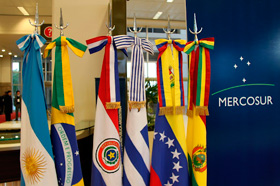Due to the political and economic transformations taking place today in Latin America, the logical question is: Will the current integration process lead to a redrawing of the future political map of this continent? What trends will prevail? Will the development of the continent be towards economic and even political integration, or will the traditional rivalry continue a long line of inter-state disputes and conflicts?
What is Latin America like today?
The abundant natural resources and rapid economic development of the Latin American countries ensures they are in the spotlight of world politics. Brazil, Mexico and Argentina are in G20 - the new elite club, which gradually replaces the "G8" and controls global processes. Brazil has already become a major international player, aspiring to permanent membership of the UN Security Council. To achieve this goal it expects to use its position in the BRICS.
Where did the "elder brother" go?
Until recently it was believed that the US controlled all the processes in its close neighbours. In reality, the situation is quite different. Whilst advancing their own political interests the US cannot even control Mexico, which is closely tied to the North American economy. The other leaders of the continent - Brazil and Argentina – are now fully independent. They need American investments, the U.S. market, but their policy is autonomous. This is manifested, in particular, in the integration processes: the Americans tried to take them under control, moving the locomotive of the North American Free Trade Association (NAFTA), which includes the USA, Canada and Mexico. Whose goal was to unite all the countries of North and South America in the single unit with NAFTA.
The United States of South America?
In the coming decades, there will possibly be two integration zones formed in the Western Hemisphere - North and South. The United States will remain the leader of the first zone, which will draw countries in Central America and the Caribbean. This zone will be characterized by the liberalization of trade and economic relations with a focus on the economy of the United States.
The other integration project will be the union of the South American countries without U.S. participation, where Brazil will claim to be the regional leader. It is on this basis, that the creation of the Southern Common Market (MERCOSUR) was initiated, and this contributed to the unification project of 12 countries in the Union of South American Nations (UNASUR). It is essential that the UNASUR aims, first of all, at the geopolitical goals with pretensions to becoming a new pole in world politics.
Whether this will lead to the creation of an interstate with the formation of supranational bodies, is not clear. Brazil intercepted the role of "elder brother" from the US.A, at least in the south of the continent that does not suit many of the countries. They see the Brazilian elites as striving for "sub-imperialistic" dominance in the region. In addition, some of these countries, particularly Argentina, themselves lay claim to regional leadership.
In this context it is possible to see Mexico, Colombia, Bolivia and Chile establishing a free trade area within the "Pacific Alliance". This project aims at expanding economic ties with China. At the same time the desire to compete with the growing influence of Brazil in the region is acknowledged.
It is clear that the Latin American countries are in need of economic integration. It may occur in the future, new customs unions, common economic zones and other structures in the framework of economic integration. However, the formation of political alliances with supranational bodies, and the more confederal forms of association seems unlikely. The prospects for the Latin America Formation such as the European Union have yet to be seen.
The parade of sovereignties
Latin America is not a "melting pot". In the context of unification the Latinos’ cultural trends are contributed by the following factors: language (most countries speak Spanish, Brazil speaks Portuguese) and religion unity (Catholicism), socio-cultural similarities, a common colonial past, belonging to the peripheral segment of the globalization process, etc. At the same time there are obvious differences in mentality, behavioral stereotypes, customs and traditions among European immigrants, the Blacks, the "Mulan" population and the descendants of the Indian natives. And, although the Latinos tend not to build insurmountable barriers between race and group, the factors that impede dialogue between civilizations, is quite tangible today.
Despite the rhetoric of the "Latin American brotherhood" it is clearly visible that relations on the continent are fuelled by rivalry and distrust. There is a difference in the perception of each other in Spanish speaking Argentina densely populated with European immigrants, which due to this claims to a higher "cultural status", and Portuguese speaking Brazil, which in the 16th - 18th centuries brought in tens of thousands of slaves from Africa, still feeling its African roots. It is difficult to expect that in the future, however distant, these two countries will be able to form a single state.
Similar problems exist in the relations between the other countries in the region. "Civilization" complexes are characteristic, even for the small states along the narrow isthmus connecting North and South America - Nicaragua, Costa Rica, Guatemala, Honduras, El Salvador, and Panama. They speak the same language, have similar problems, and included in the Central American Common Market (CACM), but, in fact, represent different "cultural" worlds. They are unlikely to have further economic integration.
The Caribbean area has its own specific character. It is different from the Latin America countries in both economic as well as linguocultural and civilizational characteristics, due not only its Spanish but also English, French and Dutch colonial heritage. These island nations are subject to investment powers outside the region, which complicates the process of combining them in the future.
The unifying trend in Latin America is the differentiation of the economic potential and level of development in the various countries. Political orientations, which are constantly changing, may also play a role, and fluctuations in the "political pendulum" are a determining factor in the history of Latin America. "The Blazing Continent" with the anti-American slogans of the 1960s after only a decade became the region of military dictatorships. At the end of the 20th - early 21st century there was a strong tendency to the "left" with a strong pull in the direction of nationalist sentiment. Today, the "left drift" is towards moderate regimes (Brazil, Argentina) and the more radical "Bolivarian axis" (Venezuela, Ecuador, Bolivia, Cuba, and Nicaragua). Further prospects for radical regimes will depend on the world market and - according to local estimations - on the political situation in Venezuela, which is the undisputed leader of this group of countries. It is possible that the entire "left wing" will shift towards pragmatic approaches with simultaneous enhancement of nationalist elements in the domestic and foreign policy. This is evidenced, in particular, in the policy of the governments of Argentina and Bolivia to nationalize foreign companies.
However, in some countries - Mexico, Colombia, Chile - the influence of supporters of the liberal market-based approaches to solving economic problems has been retained.
Who is to repaint the map of Latin America in the new colors?
Throughout the history of Latin American geopolitical games of the world have influenced the formation of boundaries and even the emergence of new states. A typical example was the creation in 1828 under the mediation of Great Britain of the Eastern Republic of Uruguay as a "buffer" zone between Argentina and Brazil.
External and internal factors are the basis of territorial disputes, many of which are so far unresolved. There were border clashes and wars between Honduras and El Salvador (1969), between Nicaragua and Costa Rica (2010), Bolivia and Paraguay (1932-1935). There were conflicts between Peru and Ecuador (1941, 1981, 1995, 1998), Colombia and Nicaragua (2008), Venezuela and Guyana (1998). Since 1941 there has been a smoldering conflict between Venezuela and Colombia – who cannot divide the waters of the Gulf of Venezuela where oil has been discovered. The roots of territorial disputes are different, but they all have something in common - the lack of prospects for resolution. Bolivia, for example, is seeking the return outlet to the ocean, lost in 1904 due to the Pacific War, but the Chileans are unlikely to agree to this, as the satisfaction of the Bolivian claims would mean splitting Chile in two. Perhaps there will be an emergence of new conflicts, particularly in Central America in connection with Nicaragua’s plans to dig a "transcontinental" channel on its land.
History shows that the Hispanics do not concede land. Argentina will never give up the Falkland Islands, annually raising a question about 'colonial anachronism' to the UN.
In Latin American history there has been only one precedent for territorial concessions, in 1847 Mexico lost to the USA in a fight for land in California and Texas. Today, however, Mexico may take revenge with demographics: there are more than 50 million people speaking Spanish in the USA. In the long run it may become predominant, with implications for race and the composition of the population. In view of the binding of Mexico to the U.S. economy and the growing flow of Mexican migrants to the north, so forms of political integration of the two countries in the future cannot be excluded, although Mexico's nationalist sentiments are traditionally strong.
In the "American projection" the sticking point is the situation around Cuba. In the probable event that there is a political change in Havana it will be a difficult problem if hundreds of thousands of descendants of Cuban refugees return from the United States requiring the return of their property. This will inevitably lead to grave consequences for the population of the island, and for the relations between Cuba and the USA, especially given the importance of the Cuban factor for the domestic American politics.
Conclusion instead of forecasts
At the dawn of the history Latin American leaders in the struggle for independence called for the idea was to create a single continental government. The prototype, the Federation of "Great Colombia" (Venezuela, Colombia, Ecuador and Panama) lasted only eleven years, from 1819 to 1830. This was the first and probably last attempt to unite all of Latin America.
Political, economic and cultural differences objectively lead to the strengthening of national sovereignty. However, the need to address the problems of the survival of Latin American countries in the times of crisis development of the globalization process, to ensure their overall energy and information security objectively helps strengthen the centrifugal forces in the region.
To forecast the future borders of the Latin American countries is impossible today. Over a century anything can happen. But even if the South American mainland is separated from North America and drifts to Antarctica, the imaginary national borders of Latin America will remain the same as before.








